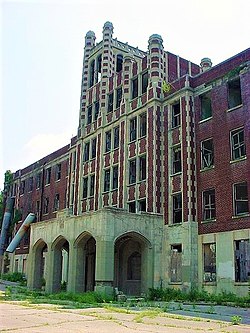Waverly Hills Sanatorium
|
Waverly Hills Tuberculosis Sanatorium Historic Buildings
|
|

Waverly Hills Sanatorium main entrance
|
|
| Location | 4400 Paralee Avenue, Louisville, Kentucky |
|---|---|
| Architect |
James J. Gaffney (1863–1946) Dennis Xavier Murphy (1854–1933) |
| Architectural style | Other |
| MPS | Jefferson County MRA |
| NRHP Reference # | 83002746 |
| Added to NRHP | July 12, 1983 |
The Waverly Hills Sanatorium is a closed sanatorium located in southwestern Louisville/Jefferson County, Kentucky.
It opened in 1910 as a two-story hospital to accommodate 40 to 50 tuberculosis patients. In the early 1900s, Jefferson County was ravaged by an outbreak of tuberculosis (the "White Plague") which prompted the construction of a new hospital. The hospital closed in 1961, due to the antibiotic drug streptomycin that lowered the need for such a hospital. Plans have been developed to convert the sanatorium into a hotel and conference center.
The land that is today known as Waverly Hill was purchased by Major Thomas H. Hays in 1883 as the Hays' family home. Since the new home was far away from any existing schools, Mr. Hays decided to open a local school for his daughters to attend. He started a one-room schoolhouse on Pages Lane and hired Lizzie Lee Harris as the teacher. Due to Miss Harris' fondness for Walter Scott's Waverley novels, she named the schoolhouse Waverley School. Major Hays liked the peaceful-sounding name, so he named his property Waverley Hill. The Board of Tuberculosis Hospital kept the name when they bought the land and opened the sanatorium. It is not known exactly when the spelling changed to exclude the second "e" and became Waverly Hills. However the spelling fluctuated between both spellings many times over the years.
In the early 1900s, Jefferson County was severely stricken with an outbreak of tuberculosis. There were many tuberculosis cases in Louisville at the time because of all the wetlands along the Ohio River, which were perfect for the tuberculosis bacteria. To try to contain the disease, a two-story wooden sanatorium was opened which consisted of an administrative/main building and two open air pavilions, each housing 20 patients, for the treatment of "early cases".
In the early part of 1911, the city of Louisville began to make preparations to build a new Louisville City Hospital, and the hospital commissioners decided in their plans that there would be no provision made in the new City Hospital for the admission of pulmonary tuberculosis, and the Board of Tuberculosis Hospital was given $25,000 to erect a hospital for the care of advanced cases of pulmonary tuberculosis.
...
Wikipedia
